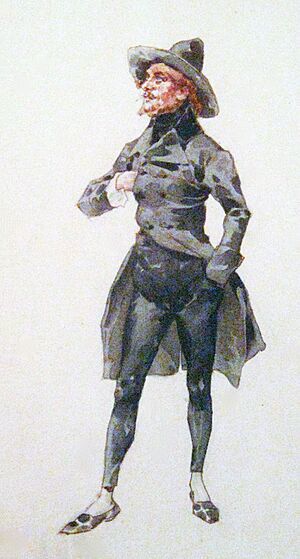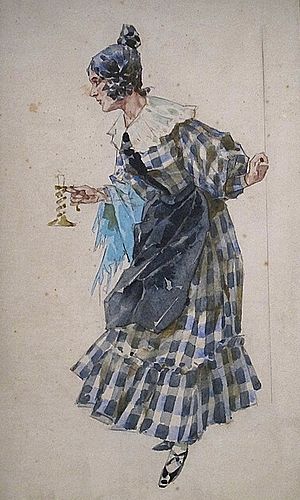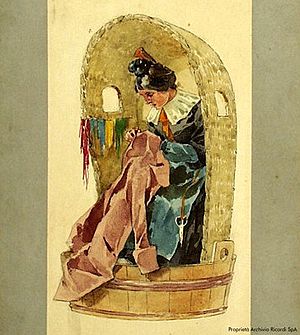La bohème facts for kids
Quick facts for kids La bohème |
|
|---|---|
| by Giacomo Puccini | |
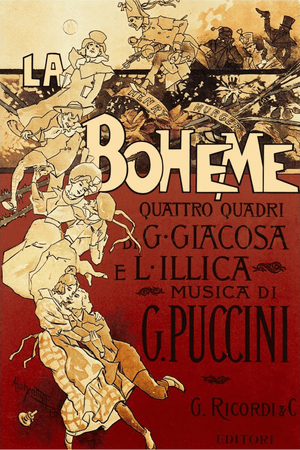
Original 1896 poster by Adolfo Hohenstein
|
|
| Librettist | |
| Language | Italian |
| Based on | Henri Murger's Scènes de la vie de bohème |
| Premiere | 1 February 1896: Teatro Regio, Turin |
La bohème ( LAH-_-BOH-em) is a famous opera by Giacomo Puccini. An opera is a play where the story is told mostly through singing, with music played by an orchestra. Puccini wrote the music for La bohème between 1893 and 1895.
The story of the opera comes from a book called Scènes de la vie de bohème by Henri Murger. It's about a group of young artists and a seamstress living in Paris around 1830. They live a "Bohemian lifestyle," which means they are often poor but focus on art, music, and friendship.
La bohème was first performed in Turin, Italy, on February 1, 1896. A young conductor named Arturo Toscanini, who was only 28, led the orchestra. Since then, it has become one of the most popular operas in the world.
Fifty years after its first show, in 1946, Toscanini conducted La bohème again for a radio broadcast. This recording is special because it's the only time an opera by Puccini was recorded with its original conductor.
The popular Broadway musical Rent was also inspired by La bohème.
Contents
The Story Behind the Opera
The story of La bohème is based on Henri Murger's book, Scènes de la vie de bohème. This book, written in 1851, is a collection of short stories about young artists living in the Latin Quarter of Paris in the 1840s.
The opera's writers, Luigi Illica and Giuseppe Giacosa, took parts of Murger's book and a play based on it. They focused on the love story between Rodolfo, a poet, and Mimì, a seamstress. The opera ends with Mimì's sad death.
Interestingly, the character of Mimì in the opera is a mix of two characters from Murger's book: Mimì and Francine. This helped to make the story more focused.
Puccini wasn't the only composer who wanted to make an opera from Murger's book. Another composer, Ruggero Leoncavallo, was also working on his own La bohème. Puccini explained that he had already started his version and couldn't stop. Leoncavallo's opera was completed later but is not performed as often as Puccini's.
Many parts of the opera's story were created by Puccini's writers. For example, large parts of Act Two and Act Three are new. However, Act One and Act Four follow the book more closely, combining different episodes. The famous scenes where Rodolfo and Mimì meet and where Mimì dies are very similar to parts of Murger's book.
Main Characters in the Opera
The opera features several main characters, each with a unique role. Here are the main singers from the first performance:
| Character | Voice Type | First Performer (1896) |
|---|---|---|
| Rodolfo, a poet | tenor | Evan Gorga |
| Mimì, a seamstress | soprano | Cesira Ferrani |
| Marcello, a painter | baritone | Tieste Wilmant |
| Musetta, a singer | soprano | Camilla Pasini |
| Schaunard, a musician | baritone | Antonio Pini-Corsi |
| Colline, a philosopher | bass | Michele Mazzara |
| Benoît, their landlord | bass | Alessandro Polonini |
| Alcindoro, a state councillor | bass | Alessandro Polonini |
| Parpignol, a toy vendor | tenor | Dante Zucchi |
| A customs Sergeant | bass | Felice Foglia |
| Other people: Students, working girls, townsfolk, shopkeepers, street-vendors, soldiers, waiters, children | ||
Musical Instruments Used
The music for La bohème is played by a large orchestra. Here are the instruments Puccini chose:
- Woodwind instruments: piccolo, 2 flutes, 2 oboes, cor anglais (English horn), 2 clarinets, bass clarinet, 2 bassoons.
- Brass instruments: 4 horns, 3 trumpets, 3 trombones, bass trombone.
- Percussion instruments: timpani (kettledrums), snare drum, triangle, cymbals, bass drum, xylophone, glockenspiel, chimes.
- String instruments: harp, violins (first and second sections), viola, cello, double bass.
- Off-stage instruments (used in Act 2): 4 piccolos, 6 trumpets, 2 snare drums.
Famous Recordings of the Opera
Many recordings of La bohème have been made over the years. Some are very famous:
- A 1972 recording by Decca, conducted by Herbert von Karajan, features Luciano Pavarotti as Rodolfo and Mirella Freni as Mimì.
- The 1973 RCA Victor recording, conducted by Sir Georg Solti, with Montserrat Caballé as Mimì and Plácido Domingo as Rodolfo, won a Grammy Award.
- A 1959 recording with Renata Tebaldi and Carlo Bergonzi was even used in the movie Moonstruck.
The very first full recording of La bohème was made in 1917 in Italy. More recently, a 2008 recording by Deutsche Grammophon featured Anna Netrebko and Rolando Villazón.
Some recordings are special because they feature conductors who worked closely with Puccini. As mentioned, Arturo Toscanini, who conducted the first show, recorded it in 1946. Also, Thomas Beecham, who helped with a London production in 1920, conducted recordings in 1936 and 1956.
While most recordings are in Italian, the opera has also been recorded in other languages, including French, German, and English.
The famous song "Che gelida manina" (Rodolfo's aria) has been recorded by nearly 500 tenors!
A Missing Part of the Story
In 1957, some old papers belonging to one of the opera's writers, Luigi Illica, were found. They contained a full part of the story that Puccini decided not to use in the opera. This "missing act" helps explain why Rodolfo seems a bit jealous of Marcello in Act 3.
This missing part of the story takes place between the Café Momus scene and Act 3. It describes an outdoor party at Musetta's home. Her landlord had asked her to leave, so her furniture was moved outside to be sold. The four main artist friends saw this as a chance for a party! They got wine and an orchestra. Musetta even gave Mimì a beautiful dress and introduced her to a young nobleman. When Mimì and the nobleman danced, Rodolfo became jealous. This explains a comment he makes later in Act 3 about a "young fop of a Viscount." As morning came, the furniture was taken away for the sale.
This same episode was included in Ruggero Leoncavallo's opera, also called La bohème, which premiered in 1897.
Other Works Inspired by La bohème
La bohème has inspired many other creative works:
- In 1959, a song from the opera, "Musetta's Waltz," was turned into the pop song "Don't You Know?" for Della Reese.
- In 1969, jazz pianist Dave Burrell released an album called La Vie de Bohème. It was an experimental jazz album that still used some of Puccini's musical ideas.
- The 1996 musical Rent by Jonathan Larson is directly based on La bohème. In Rent, the main characters, Roger and Mimi, face challenges like AIDS. Many character names are similar, and the musical even includes a reference to "Musetta's Waltz."
- The novelist V. S. Pritchett wrote a short story based on the opera in 1983.
Modern Versions of the Opera
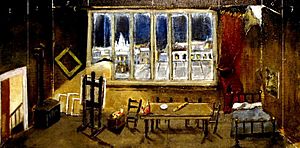
- Baz Luhrmann's Production: In 1990, director Baz Luhrmann created a new version of La bohème for Opera Australia. He set the story in 1957 instead of the 1830s, believing that time period matched the original story's feeling. This production was later brought to Broadway in 2002 and won two Tony Awards.
- OperaUpClose Production: In 2009, Robin Norton-Hale directed a production in London where the audience and cast moved downstairs to a real pub for Act 2. The pub's customers even became part of the scene! This show won a Laurence Olivier Award.
- Against the Grain Theatre: A 2019 Canadian production by Against the Grain Theatre moved the story to a modern Canadian city. It used an English translation of the opera.
Images for kids
See also
 In Spanish: La bohème (Puccini) para niños
In Spanish: La bohème (Puccini) para niños


